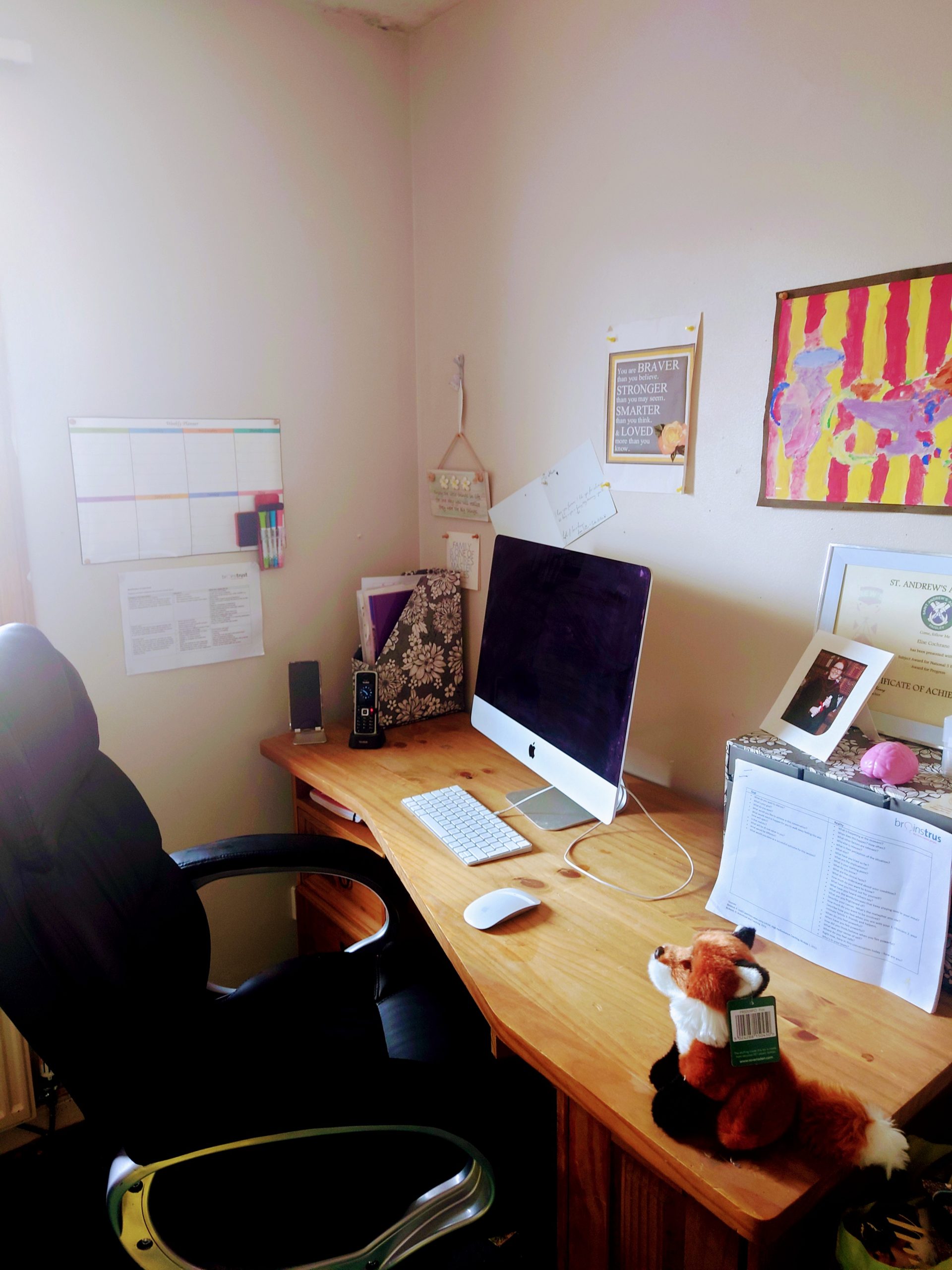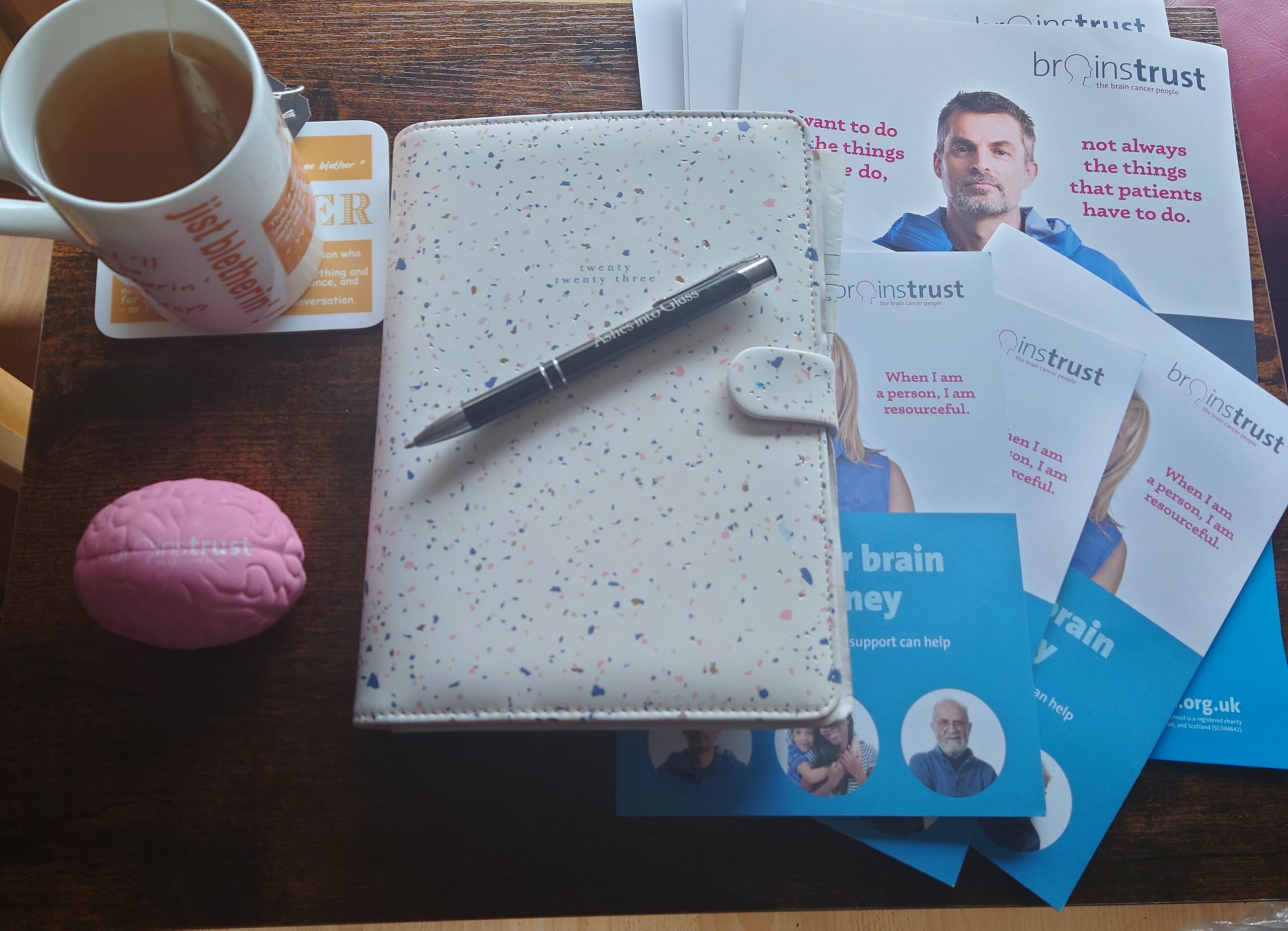Hi, I’m Carol and I’m brainstrust’s support specialist for Scotland. I’ve been with brainstrust nearly 10 years now. I initially contacted brainstrust for information when my dad was diagnosed with a glioblastoma; the support brainstrust offered us was so personal, unique and invaluable. It had such a massive impact on me and my family that when my dad sadly died, I wanted to be able to help and support other families facing a brain tumour diagnosis.
No two days are the same at brainstrust and it’s a privilege to work with the brain tumour community and be part of such a dynamic, committed team. I’m based at home in Central Scotland. Let me share my day with you.

9.00-9.30am – I start the day by checking my emails as there’s sure to be some that have come in overnight. I also check through my list of priorities for the day. I’m very old school – as well as everything on the computer I have a paper diary that I use. At this point I’m joined by Wilma, my little dog and unofficial brainstrust Scotland mascot (as well as maker of mischief!) at my feet.
9.30-11am –Today I’m pulling together our online events calendar for the month. We introduced online events during the pandemic. Initially it was just a few meetup groups and coaching workshops to see people through what we thought would be something short term. We wanted to ensure our community remained supported and connected during this period. But appetite grew from our community and we now offer a hybrid approach. Our online events are wonderful for connecting our community – people have a safe space to meet with others from the comfort their sofa.
We offer a rich and diverse variety of online groups from our tumour specific meetup groups, to our coaching workshops led by the support team and art and hypnotherapy classes. We also have guests from the clinical community speaking on subjects that matter to our community.
Our webinars are very much led by what our community telling us what they need and would like.
Our super Support Team Helen, Jodie, Rosie, Mariel, Laura and Molly send me the webinars they are hosting and I collate the information and send it to Catherine who prepares the graphics for Eliza, our Communications Manager, to share on our social media.
11.00-12.15 – I have a coaching call with Fiona. She has surgery scheduled and is understandably feeling anxious and overwhelmed, so we work on some coaching tools to help her feel more in control. People are often anxious and overwhelmed at the prospect of surgery and chatting with people who understand and can answer questions to alleviate any fears can make all the difference. Working through their biggest concerns and using coaching tools to help can help people feel more in control.
I also suggest she signs up to our hypnotherapy sessions. We run online hypnotherapy sessions with our wonderful Hypnotherapist Louise. This initially started during the pandemic with Louise running online sessions to help with the additional overwhelm and uncertainty people were feeling. The appetite really grew for these sessions and attendees provided us with such good feedback that they are now a regular part of our online calendar of events.
12.45-1.30pm – I have a chat with Ashleigh on Zoom who works at a charity within a local hospital. She had contacted me, keen on signposting people to our services and wanting to know more about us and the support we can provide. From our initial chat she then asked if I would be prepared to visit her and her colleagues to talk about sharing brainstrust’s work so they have a better understanding of our services when they are signposting patients and carers to us. We run through what I will talk about. I’ll be taking a presentation, our famous brain box and our resources to share with the staff. We have a very good relationship with other cancer charities who are always happy to signpost to us.
1.30-3.00pm – I have some papers to read through that have been sent prior to tomorrow’s Neurological Alliance of Scotland meeting. I sit on the Executive – the Alliance is an umbrella body of organisations that represent people with neurological conditions and those who support them. There are a wide variety of neurological conditions represented and brainstrust represents the brain tumour community on this National Group.
Neurological Alliance of Scotland meeting. I sit on the Executive – the Alliance is an umbrella body of organisations that represent people with neurological conditions and those who support them. There are a wide variety of neurological conditions represented and brainstrust represents the brain tumour community on this National Group.
3.15-4.15pm – I have some emails that I reply to. This can be anything from replying to requests for resources, answering questions, responding to queries about our coaching services, our online events or even an update from a patient or caregiver to let me know how they are. Working with a regional model of support really helps when we respond to patients and caregivers as we are familiar with local services.
4.15-5.00pm – I take a phone call regarding a GBM patient and clinical trials. Mel’s uncle has been diagnosed with a GBM and she’s enquiring if there are any clinical trials or other options available. A lot of our community are very pro-active and are keen to get as much information regarding clinical trials and options outside the NHS. I let her know about the high grade knowledge share group that meets monthly. The group is for anyone who wants information about treatments that sit outside NHS protocols. It’s a great group where you can ask about anything related to unproven, innovative and adaptive treatments. As this is her first time contacting brainstrust we chat about the support we can provide for her and her family including our brain box which she would like to receive. I make sure there is nothing else she is struggling with.
5.00-5.30pm – I write up the information from Mel and ensure that her brain box has been ordered, I also follow up with an email to her outlining what we spoke about and containing links to what we discussed. She also now has my email for direct contact if she has any further questions or just needs a chat.
I finish up my work for the day – check my to-do list and ensure it’s been all ticked off and make sure there’s nothing left that is urgent and must be done today.
Then it’s time to spend the evening with my family. Wilma has conveniently left a pile of toys at my feet so playtime with her beckons….
Our team may all be spread out geographically, but we work closely and share the same commitment. One of the things that sets brainstrust apart is the fact that no matter where you live you have your own designated regional support specialist, so you have a point of contact. We get told time and time again how invaluable this is – the joy of local definitely has an impact!








